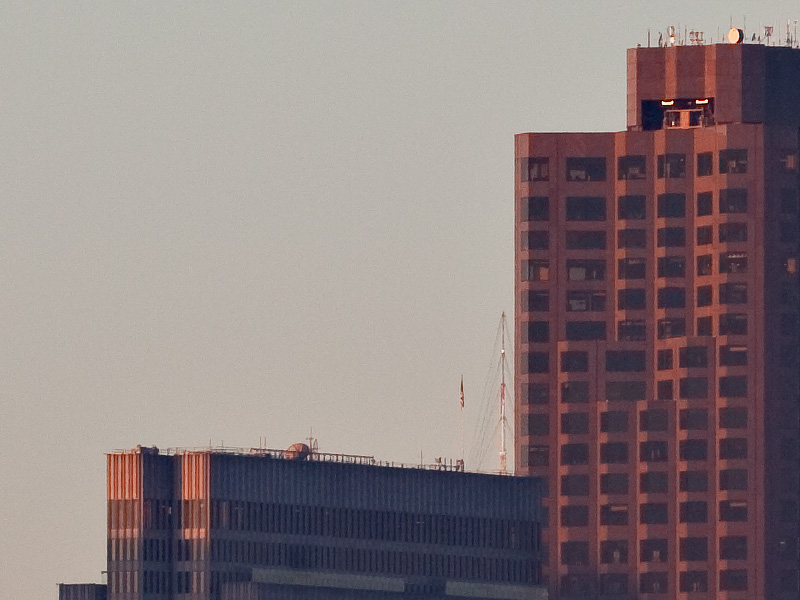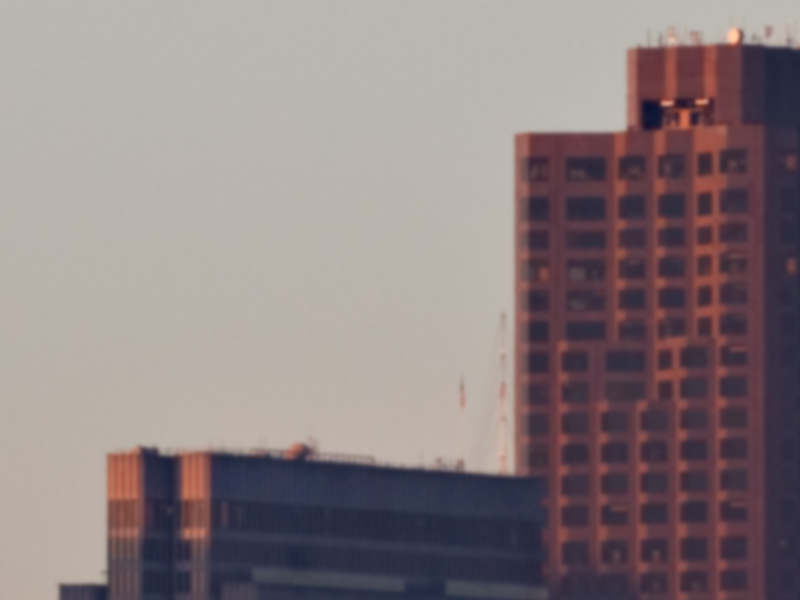Here is the answer to the questions I asked in the little experiment that I posted earlier today. (see “Experiment #1: What do you see?” And, my apology for the formatting issue that may cause the image on this page to extend into the sidebar. This is the result of a modification to the web site made over a year after the original posting of this message. I have decided to leave the example images intact, with the side-effect of the odd formatting.)
Examples A and C are completely identical – two copies of the very same file. To be clear, there is literally no difference between them. One is a simple copy of the other file with a different name. Here is a 100% magnification crop from the source file used for A & C:

Example B came from a different source file. The blur was added to the original file in post, so it is uniform across the entire image both in the source file and in example B posted here. This source file was then converted to jpg in exactly the same way that the other file (e.g. – the other two examples) was converted. Here is a 100% magnification crop of the source image used for example B:

So, A and C are literally identical. B came from a source file that was so blurry that it looks like it was shot with a defective lens.
Thank you to all of you who took the challenge and looked long and hard at the sample images. I have three more little tests planned for sometime in the near future.
Dan
Discover more from G Dan Mitchell Photography
Subscribe to get the latest posts sent to your email.

I liked B the best of the 3 in your original challenge. C seemed too bright, and A slightly too dark or not contrasty enough near the bottom of the building — for my tastes. Other than that I can say that on my 28″ 1080p monitor, these shots look like 4×6 postcard sized images, and I’m used to stretching pictures to fit 20″ wide.
But from the perspective of 100%, I have to say this:
You take a picture with a (5DII) camera at 5616×3744 and resize it to 600×400. Every pixel in the resulting image represents a pseudo 9.3×9.3 region of pixels in the original image. So for each pixel in the resulting image, 87.6 pixels worth of data were averaged together. If your blur kernel had a radius equal to or less than 9.3 pixels then you simply changed the weighting of the average so that some small/insignificant part of the bordering 9.3 pixel group was factored in.
You’d probably need to blur by at least 9.3 * sqrt(2) pixels in radius (which is to say, at least double the area) in order for the effect to be meaningful after reducing your image that much. I did a quick peek in Paint at 800% on your blurred picture on one of the radio/cell towers, and it looks like you blurred by fewer than 9 pixels in radius. It’s clearly not enough from an image processing/image algebra perspective.
Also, remember that your original 5616×3744 picture really only has a minimum of 1/4 – 1/2 the spatial resolution (where there is low local contrast in one or two color channel even though there is high local contrast in other channels, the exact location of the edge is determined by algorithm to the nearest color element). Demosaicing (a topic I studied for many years) is an art and a science, and it “invents” 2/3rds of your pixel data. It’s usually not a problem because edges tend to be spatial in nature as different objects have entirely different properties for the way they transmit, absorb, reflect, and scatter light of various wavelength, so generally these color edges should be correlated, but they aren’t measured correlated – they are sampled from neighboring values, and these samples can have errors.
-Mike
Mike:
This test has provoked a certain amount of careful and critical thinking by those who participated, and I thank you for your contribution.
Just for the record, I know a bit more about this than some might think (though not to the level perhaps of those who have specialized in the study of digital image sampling) from my background with digital audio. With that in mind and knowing that I was roughly converting a 9 x 9 pixel area (more than 80 data points) to a single pixel I thought about pushing the Gaussian blur radius to about 4.0 instead of 2.0. In the end I decided not do to that because the 2.0 radius already produced more blur (technically I might describe it as “God awful horrible blur!” :-) than you would see from any even moderately decent lens, much less the sort of lenses that I use in my photography. If I had a lens that produce that blur in the “bad” sample (see my follow up message) I would return it or send it back to the factory immediately.
So, the choice of the 2.0 radius did recognize that I’d be well within the half sampling rate range but, more important, that it went to and slightly beyond any real world blur that people would encounter with their gear.
I suspect that the results would have been largely the same if I had used a blur radius of 4.0 – though I’m not certain. For what it is worth, there were a very few participants (two, out of perhaps 50 or 60 in the various places I posted this test) who correctly identified the “different” image and described the difference in terms of “less sharpness” or “less detail” in the image that started out blurred.
The idea for this test idea grew out of a (rather heated) forum discussion pitting folks who believe that the differences between photos made using good lenses with a high quality APS-C cropped sensor camera and the same photographs made with the same quality lenses but full frame bodies would be plainly obvious in downsized web jpgs. I think there is precious little evidence that this would be the case, with the possible exception of some particular images shot at very large apertures.
Dan
Sherwood, I may have been a bit confusing about this.
The answer to the fundamental question is that A and C are identical and that B is different.
The underlying question for photographers might be whether the differences are or are not significant. I did not directly answer that question, though I think some conclusions can be drawn based on the responses to the question I got from perhaps 40-50 people who took that challenge here and in two other places where I posted it. I think that you and I would likely come to the same conclusion about this.
What i offered was a somewhat informal version of what I heard described as a “ABX” test. It attempts to determine whether there are perceptible differences among test subjects and whether those differences can be correlated to the perceptual abilities of the participants or they should be regarded as random. If presented with A and B and told they are different many people will assume that they are different and that the difference must be visible and they will come to a conclusion that one or the other is “better.” However, when asked to also consider a third sample and determine which of the first two samples it matches we have a sort of control for guessing or for making a choice based on irrelevant parameters.
If there really is a perceptible and significant difference between A and B the subjects now must be able, as a group, to perform two tasks. First they must be able to determine that they see a difference between the test cases. Second, they must be able confirm that their choice is significant by recognizing a pairing among the three choices.
Overall, when I look back at the “answers” I got here and elsewhere on this “experiment” there were a few people who correctly identified B as being different from A and C and identified A and C as being the same. But there were a substantial number who also said all three seemed identical (the large majority of those who “voted”) and among those who thought there were differences there were at least as many incorrect choices as correct.
In the end, “as they were presented, I… maintain that there was no detectable difference.” However, believe it or not, there are some folks – who did not post here, by the way – who vociferously hold to the idea that there must be significant differences, and some are just plain angry that anyone would suggest otherwise.
A Bridges may have been one of those who chose the “correct” answer – I haven’t checked. However, I’m afraid that this doesn’t prove tha the difference in sharpness was detectable. If the participants had to some degree consistently chosen the “correct” option and correctly identified B as the “odd man out,” then we could claim that the sharpness is perceptible. However, most people could perceive no difference, and among those who claimed to perceive a difference there were more – by a significant number – who claimed to see a difference that did not exist than one that might. In other words, there is not indication here that the accuracy of the choice is better than flipping a coin to chose.
(It is also significant to point out that in the real world people don’t get to flip back and forth between three sample images on the web and carefully and painstakingly compare them. In addition, there are significant variations in monitor color and luminosity and ambient light and other variables that swamp the truly tiny differences in these samples.)
Dan
The difference in sharpness is perceptible at the sizes at which the images were originally presented (see my response to the challenge). The decreased sharpness of #2 was evident in the part of the photo Dan presents above, especially in the box-shaped windows on the right building. The dark windows became blended more with the bright outlines of the building in #2, but they were equally distinct on #1 and #3.
I agree, however, that a 100% crop does not answer a question about a web-sized reproduction.
Dan, I disagree that this is “the answer to the questions [you] asked in the little experiment.” While the difference between B and the other two is obvious at 100 percent magnification, among your instructions to us was this:
“The question is not ‘what would they look like at 100% magnification?’ Interesting question, but here the question is just about what you see in the images as presented.”
As they were presented, I still maintain that there was no detectable difference. The lesson I draw from the exercise is that compression of an image to suit a “web-friendly” file size can degrade image quality — something we already knew, of course, but this exercise provides a nifty case in point.